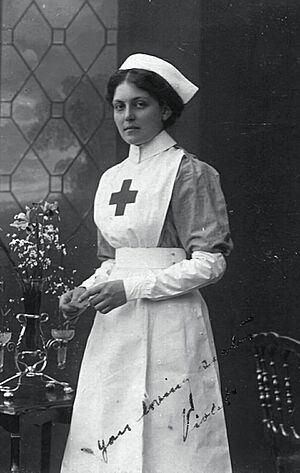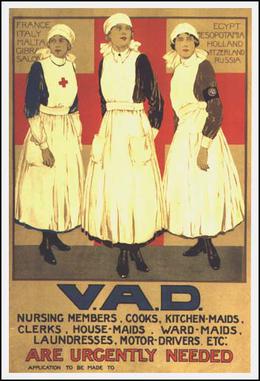Voluntary Aid Detachment facts for kids

The Voluntary Aid Detachment (VAD) was a group of everyday people who volunteered to help care for soldiers. They provided nursing care for military personnel in the United Kingdom and other countries that were part of the British Empire. These groups were most active during World War I and World War II. Even though VADs were a big part of the war effort, they were not official military nurses. This is because they were not controlled by the military. VAD nurses worked in hospitals close to the battlefield, called field hospitals. They also helped in places back in Britain where soldiers recovered for longer periods.
Contents
VADs in World War I

The VAD system started in 1909. It was created with help from the British Red Cross and the Order of St John. By the summer of 1914, there were over 2,500 VAD groups in Britain. About two-thirds of the 74,000 VAD members in 1914 were women and girls.
When World War I began in August 1914, VAD members were eager to help. The British Red Cross and the Order of St John decided to work together. They formed a Joint War Organisation to help the war effort more effectively.
At first, the British Red Cross was not sure about sending civilian women to hospitals overseas. Many volunteers came from wealthy families and were not used to hard work or strict hospital rules. Military leaders also did not want VADs on the front lines. But as the war continued, VADs started working in many local hospitals. They helped patients who were moved between different hospitals.
Soon, there was a big need for more nurses. This opened the door for VADs to work in military hospitals overseas. By 1916, about 8,000 trained nurses worked in military hospitals in Britain. There were also 4,000 nurses working abroad. By 1918, there were around 80,000 VAD members. About 12,000 of them worked as nurses in military hospitals. Another 60,000 volunteers worked without pay in other types of hospitals.
At first, VADs were not always accepted easily in military hospitals. They did not have the same advanced skills as professional nurses. However, as the war went on, VAD members became more skilled. Trained nurses also began to appreciate their help more. During the four years of the war, 38,000 VADs worked in hospitals. They also served as ambulance drivers and cooks. VADs helped near the Western Front, in Mesopotamia, and in Gallipoli. Many VAD hospitals also opened in large towns across Britain. Later, VADs were sent to the Eastern Front too. They provided very important help to the war effort. Many VADs received awards for their excellent service.
After the war, nursing leaders decided that untrained VADs should not be added to the official list of nurses.
Famous VAD Helpers

Many VADs became famous for their work or for what they did after the war.
Writers and Their Stories
Some VADs wrote books about their experiences:
- Vera Brittain wrote a famous book called Testament of Youth. It tells about her experiences during World War I.
- Agatha Christie, a well-known British author, briefly wrote about her VAD experiences in her Autobiography.
- Enid Bagnold, who wrote the novel National Velvet, shared her experiences in her memoir A Diary Without Dates.
Other Notable VADs
- Violet Jessop was a British ship stewardess. She became a VAD nurse during World War I. She was also a stewardess on the RMS Titanic when it sank in 1912. Later, she was a Red Cross nurse on the hospital ship HMHS Britannic (the Titanic's sister ship) when it sank in 1916.
- Amelia Earhart was a famous American pilot who helped as a VAD.
- Hattie Jacques became a well-known English comedy actress.
- Sophia Duleep Singh was a suffragette, a woman who fought for the right to vote.
- Freya Stark was a famous explorer and travel writer.
See also
- Voluntary Service Detachment, a similar group in Australia
Sources
- A VAD in France, Olive Dent, Diggory Press, ISBN: 978-1-905363-09-4


